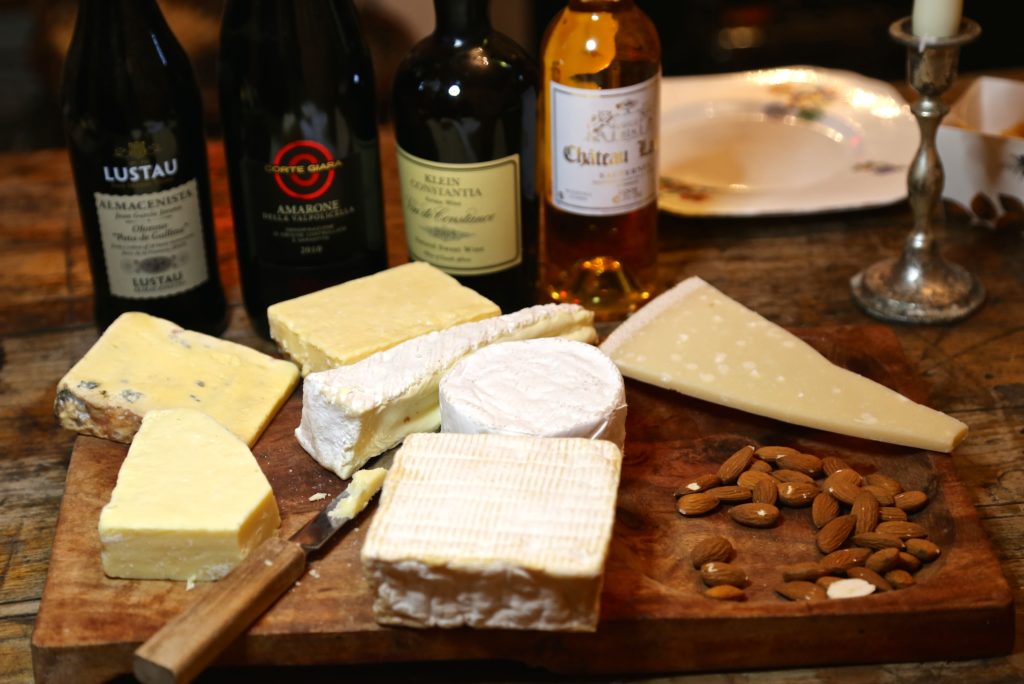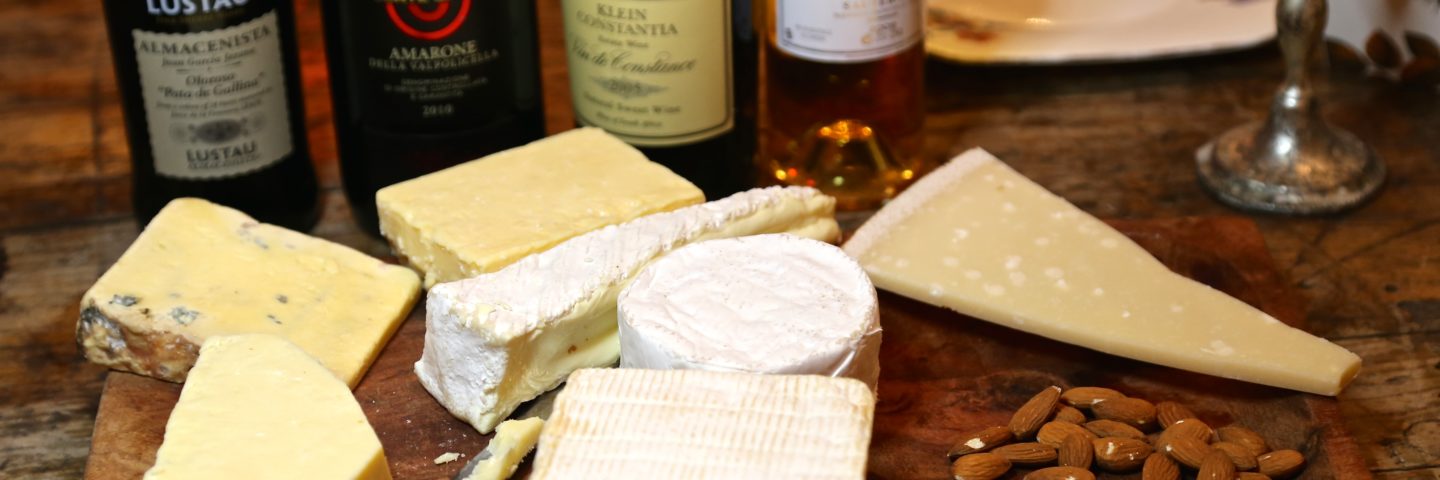[twitter style=”horizontal” float=”left”] [fbshare type=”button” width=”100″] 
Here is a journey through the cheese board, pairing each category of cheese with the perfect wine match. I have also written a list of tips on how to create a fabulous cheese board.
Remember, when devising a cheese board, always start with the mildest cheeses, working up to blue cheese, the strongest. Include a variety: say one goat, one cow’s, one hard, one soft, one blue. Think also about shapes and colours of cheeses: a triangular wedge, a soft semicircle, a round truckle, an oozing slab… wrapped in leaves, or veined with blue, or with a washed orange-hued rind…
Do explain or even label the cheeses. People love food stories; they love to know where their food comes from, what it goes with…
The best thing about cheese is: you don’t have to cook anything! It’s the ultimate lazy-arse way of entertaining. If you ask guests at the end of a meal ‘what did you like best about the meal?’ they will almost always say ‘the cheeseboard’.
I tend to spend a lot of money on cheese; especially at special occasions like Christmas when you can push the boat out. That is the moment to visit your local cheese shop and of course, order great wines to match the cheeses.
Soft Cheese
This includes Brie and Camembert which are soft-rind cheeses where you can eat the rind.
Wine Match: an oaky chardonnay would be good with a slightly more mature, runny, soft rind cheese. Try the 2012 Chardonnay, Chamonix from South Africa 13.5% £14. A slightly oaked chardonnay would work with a younger chalkier soft rind cheese: 2011 Indaba, Chardonnay 13.5% £9.50
For a Langres cheese (one of my favourites) or say a Brillat-Savarin cheese (gorgeously creamy) I’d choose champagne as a match. I once served a whole melted Langres cheese with Marmite fingers and Champagne for a supper club. It went down a treat. Marmite is fabulous with Champagne. Winetrust100 has five French champagnes on this site at present, ranging in price from a reasonable £20 to a special occasion £49.
Gremillet, Brut selection £20
Ayala, Brut Majeur £25
René Jolly, rosé assemblage brut £31
Charles Heidsieck, Brut Reserve £38
Charles Heidsieck, Brut rosé réserve £49
Washed rind cheese
These are orange-skinned soft cheeses that can be mild or very strong, depending on how long they have been matured. I would go for an aromatic Gewurztraminer (which matches the Munster cheese from the Alsace region), 2013 Paul Cluver Gewurztraminer 12.5% £12 or a Riesling such as 2010 Sybille Kuntz estate Riesling 11.5% £15. Or you could try a dessert-style wine such as the sweet Riesling ‘icewine’ such as 2012 Inniskillin Riesling Icewine from Canada 9.5% £50
Stinky, often ammonia smelling cheeses include Stinking Bishop and Pont L’eveque. The only direction you can go when drinking with these cheeses is sweet and heavy: 2008 Vin de Constance, Klein Constantia 14% £35. Yes it’s pricey but Napoleon’s favourite tipple (he had a case sent to him monthly while imprisoned on St. Helena island) is beautifully packaged and would make a lovely Christmas present in itself.
Goat cheese
I’m a goat girl when it comes to cheese; I prefer the chalky goat cheeses, such as a slice of Bucheron (log) to the soft rind ones. Bucheron comes from the Loire in France so it matches beautifully with Loire valley wines such as 2013 Domaine Chauveau Pouilly Fumé 13% £12
A Cabecou or a Crottin de Chavignol, tiny nutty cheeses are complemented by Sancerre wine such as 2011 Domaine de la Garenne 13.5% £15.
Hard Cheese:
Wonderful British cheeses such as Cheddar, Cheshire, Caerphilly, Lancashire and Wensleydale are great with red wines. Contrary to popular wisdom, many cheeses are not well matched with red wine but hard cheeses are the delightful exception. Try Corte Giara Amarone Valpolicella 15.5% £25 or a classic Bordeaux such as 2010 Chateau des Gravières 13 % £12
Blue cheese:
Port is the classic match for British blue cheese such as Stilton or Colston Bassett. Try the 2007 Quinta Da Romaneira LBV Port, 19% £16
For French blue cheese such as Roquefort, a sweet Sauternes is the traditional match. Try the 2009 Chateau Laville Sauternes, 13.5% £17
- Accompany your cheese board with a scattering of nuts, some sliced and/or whole fruit such as pears or apples, chunks of honeycomb, (blue cheese matches especially well with a drizzle of honey), chutneys, fruit ‘cheeses’, or pungent Italian ‘mustard’ fruits (mostarda di frutta, available in Italian shops and delis).
- You can eat cheese with bread or crackers. The French tend to eat cheese with bread whereas we use crackers. Try making your own seed crackers! Use a mix of types of bread and cheese biscuits, of different grains, shapes and colours; it will make your table look very attractive.
- Make sure you cut the cheese correctly. Never just shave off the point, for instance, with a triangular cheese. That is a complete no no. With a square or circular cheese, cut in slices like a cake, using your knife tip to find the centre point of the cheese. With a blue cheese, cut in triangles radiating from centre of the lower end of the wedge, the first cut will be a corner.
- Cut from the rind to the tip to get the full flavour. In general, the rind of soft cheeses is edible and the rind of hard cheese isn’t. The cheese nearer to the rind has more tang.
- A proper cheese knife has an edge for cutting and two tips for lifting up the cheese onto your plate.
- If not serving as a cheese board but plated, give each guest about 15 to 25g of each cheese depending on how many you are serving. Cheese is very rich, you don’t need too much.
- Cheese is great for the digestion, the teeth and for counteracting acids in the meal. This is why the French eat cheese at most meals. The French are experts on the delicate science of ‘digestion’, they are obsessed with it. They seem to have a morbid fear of food not going through their bodies properly. French wives use poor digestion, not headaches, as an excuse not to have sex.
- You can serve cheese French style, that is, directly after the main course, or British style, after pudding. People tend to linger over cheese, so it depends how long you want your guests to stay!
- You don’t have to serve cheese with wine; a dessert wine, port, Madeira, beer or even champagne can go very well with cheese
How to keep and serve your cheese:
- Keep at 4ºC in the fridge for optimum preservation. Fridge temperature gages are cheap and worth having in the fridge, for food safety reasons.
- Take it out of the fridge 1 hour 30 minutes before serving to bring it to room temperature. The flavours really come out.
- Soft cheeses should be taken out of the fridge 30 minutes before serving.
- Once taken out of the packet, wrap any leftovers in foil or greaseproof paper and return to fridge. Never wrap cheese in cling film. It needs to breathe.
- The only cheese that can be wrapped in cling film is cream cheese. Hard cheeses must be freshly wrapped in greaseproof paper every time they are used.
- Leftovers can also be crumbled into pasta, salads, used in salad dressing. Make the most of your cheese.
- Blue cheese lasts up a year if kept well. The longer you keep blue cheese, the stronger it becomes, so if you like it strong, you can mature it yourself.
Do let me know in the comments if you have any favourite wine and cheese matches. Do you agree with the wine experts that red wine doesn’t match with most cheese? I’m really not sure about this, but what do you think?
Coming soon: what wines to give as a present for Christmas. (At a loss what to give the man in your life? Ordering from WineTrust100 is the easy way out. Perfect dad presents.)
[twitter style=”horizontal” float=”left”] [fbshare type=”button” width=”100″]

